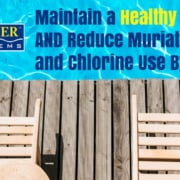How Much Acid Should You Add to Balance Your Pool pH Levels?
Maintaining proper pH levels is essential for keeping your swimming pool safe, comfortable, and durable. When pH levels rise above the optimal range, adding acid can help restore balance. But how much acid should you add, and how does it work? In this blog post, we’ll explore how to determine the right amount of acid to add and how acid and alkalinity react to create carbon dioxide (CO2), which brings the pH down.
Determining the Right Amount of Acid to Add
The amount of acid you need to add to balance your pool pH levels depends on factors such as the pool’s size, current pH and Total Alkalinity level, and the type of acid you use. A general rule of thumb is to add one quart of muriatic acid per 10,000 gallons of water to lower the pH by 0.1. However, always refer to the acid manufacturer’s instructions and test the water frequently to avoid overcorrection, which can cause pH levels to drop too low, leading to skin and eye irritation, and damage to pool equipment and surfaces.
How Acid and Alkalinity React to Create CO2
Adding acid to pool water neutralizes alkalinity and creates carbon dioxide, which lowers pH levels and balances the water. Alkalinity acts as a buffer, resisting changes in pH levels, but it can also cause pH to rise when it gets too high. By adding acid, you neutralize alkalinity, and create CO2, which helps lower pH levels. Just like the baking soda and vinegar volcano from school produces acid, you’re doing the same thing in your pool with a much stronger acid.
Health and Safety Concerns of Acid
While adding acid is an effective way to balance pH levels, overuse can lead to health and safety concerns. Acid is a corrosive substance that can cause skin and eye irritation, respiratory problems, and even chemical burns. It’s crucial to handle acid with care, wearing proper protective equipment such as gloves, goggles, and a respirator mask. If acid contacts skin or eyes, flush immediately with water and seek immediate medical attention. When adding acid, do not inhale any fumes as they are deadly.
Make sure you always add the acid into the water. If you dilute the acid in a bucket, make sure you fill the bucket with water first to prevent the acid from splashing. Also, make sure you wait at least 15 minutes in between adding acid and chlorine as they can react to form deadly chlorine gas.
Alternative Solution for pH Control
If you are tired of constantly adding acid and battling to get both pH and alkalinity in range, there are alternative solutions available. One of the easiest ways to control pH is by injecting CO2 directly into the water. pH Pure is a CO2 injection system designed for residential pools that helps maintain a perfect balance. Unlike acid and alkalinity, injecting CO2 doesn’t alter the Total Alkalinity in the water, which remains the same, and pH is controlled daily.
Conclusion
Balancing pH levels is crucial for maintaining proper water chemistry in your pool. All sanitizers such as chlorine are more effective when the water is well balanced. While adding acid is an effective solution, it’s essential to understand the potential health and safety concerns and negative effects of overuse. By handling acid with care, testing the water frequently, and exploring alternative solutions such as pH Pure, you can ensure that your pool is safe and comfortable for swimmers and properly maintained for the long term.















